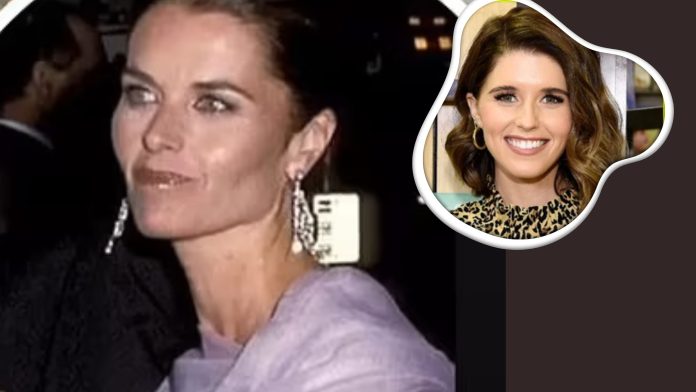- Katherine Schwarzenegger subtly shades Met Gala 2024 by reposting a throwback photo of her mother from 2001, suggesting a shift from “chic and classy” to more risqué outfits.
- Maria Shriver’s 2001 Met Gala experience was described as “low key” and highlighted the elegance of her attire, contrasting with the 2024 event’s bold fashion choices.
- The 2024 Met Gala featured a range of outfits from conservative to extremely daring, reflecting broader changes in fashion trends and societal norms regarding dress codes for public events.
Newsypeople – Katherine Schwarzenegger, the daughter of Arnold Schwarzenegger and Maria Shriver, recently took to Instagram to express her thoughts on the 2024 Met Gala, posting a “classy” throwback photo of her mother at the event in 2001. This move can be interpreted as a subtle critique of the current direction of the Met Gala, suggesting a preference for the event’s past elegance over its recent trends.

The Met Gala, known for its extravagant fashion statements, saw a variety of bold looks this year, including Doja Cat’s “wet” T-shirt dress and Tyla’s sand-covered gown. However, Schwarzenegger’s Instagram post, featuring her mother in a lavender gown with a matching sheer shawl and diamond jewelry from 2001, seems to contrast with the more daring and unconventional outfits showcased at this year’s event. Continue reading to get the complete details of what happened.
Katherine Schwarzenegger Shades Met Gala, Shares Mom’s Classic 2001 Look
Katherine Schwarzenegger, the 34-year-old author recently posted a throwback photo of her mother, Maria Shriver, attending the Met Gala in 2001 on her Instagram stories.
This action was interpreted as a subtle shade towards the 2024 Met Gala, where attendees were noted for their risqué outfits, contrasting with the more traditional and “classy” attire seen in Maria Shriver’s throwback photo. Katherine’s post included the caption, “When the met gala was chic and classy,” highlighting a perceived shift in the event’s fashion direction.
Maria Shriver’s original post from 2001 described her experience at the Met Gala as “low key” compared to the current event, mentioning the beauty of her dress and the joy of attending with her family. The throwback photo showed Maria in a sleeveless, lilac gown with a sheer shawl, reflecting a more conservative and elegant style compared to the 2024 attendees’ choices.
The 2024 Met Gala, themed around “The Garden of Time,” saw several celebrities, including Zendaya, Kim Kardashian, Jennifer Lopez, Gigi Hadid, Cardi B, and Kendall Jenner, showcasing a variety of outfits. Some attendees, like Rita Ora, Doja Cat, and Emily Ratajkowski, opted for bold and risqué ensembles, drawing attention for their daring fashion choices.
Katherine Schwarzenegger’s action of reposting her mother’s throwback photo and adding a comment about the Met Gala’s past elegance can be seen as a critique of the current trend towards more revealing and unconventional outfits at the event. This move aligns with broader discussions about the evolution of fashion trends and the changing standards of what is considered appropriate for high-profile events like the Met Gala.

Schwarzenegger’s post comes amidst a period of notable absences from the Met Gala, with several high-profile attendees such as Blake Lively, Ryan Reynolds, Rihanna, Jared Leto, Taylor Swift, and Travis Kelce not participating. The absence of these celebrities, coupled with Schwarzenegger’s nostalgic throwback, suggests a shift in the perception of the Met Gala, moving away from its recent focus on shock value towards a more traditional appreciation of fashion and elegance.
Met Gala Evolution Over The Years In Terms Of Fashion Trends
The Met Gala, initially a modest fundraiser for the Costume Institute, has evolved significantly over the years, transforming into a global cultural phenomenon that showcases the intersection of fashion, art, and celebrity culture. This evolution is marked by shifts in themes, the introduction of elaborate costumes, and a growing emphasis on creativity and boundary-pushing fashion statements. Here’s a breakdown;
The Met Gala began in 1948 as a charity event organized by fashion publicist Eleanor Lambert to support the Costume Institute. Initially, it was a relatively low-key affair, attended by members of high society who appreciated the intersection of art and fashion. The event’s location varied, moving from venues like the Waldorf Astoria and Central Park to the Metropolitan Museum of Art in 1971.
The Met Gala’s transformation into a more elaborate and culturally significant event began with Diana Vreeland’s appointment as a consultant to the Costume Institute in 1973. Vreeland introduced gala themes, such as “The World of Balenciaga,” and worked on exhibitions that highlighted various aspects of fashion and design. This period marked the beginning of the Met Gala’s association with popular culture and its increased publicity and press coverage.
Anna Wintour, who took over as chairwoman in 1995, played a crucial role in further elevating the Met Gala. She oversaw the benefit, guest list, and theme, working closely with the Met each year. Wintour’s influence extended to approving the designs worn by high-profile guests, emphasizing the event’s role in showcasing the latest in fashion and design. She also moved the date of the Met Gala from December to the first Monday of May, marking the start of the fashion week season.
The Met Gala became known for its extravagant costumes and themes starting around 2004, with the theme “Dangerous Liaisons: Fashion and Furniture in the 18th Century.” This period saw a surge in elaborate costume moments, with guests like Amber Valletta wearing Marie Antoinette-meets-punk rock looks. Over the years, the event has featured exhibitions dedicated to specific designers, further enhancing its reputation as a platform for fashion creativity and innovation.
The Met Gala has increasingly served as a platform for designers and celebrities to showcase their creativity, often aligning their outfits with the annual exhibition’s theme. This shift has led to a more diverse and captivating range of fashion statements, sparking conversations and inspiring future trends. The event’s influence on the fashion industry is significant, with designers eagerly awaiting the event each year for inspiration.
the Met Gala is expected to continue evolving, embracing new themes and leveraging digital platforms and immersive experiences to engage a broader audience. As fashion and technology intersect, the event is poised to create more memorable and impactful experiences for participants and viewers worldwide.



